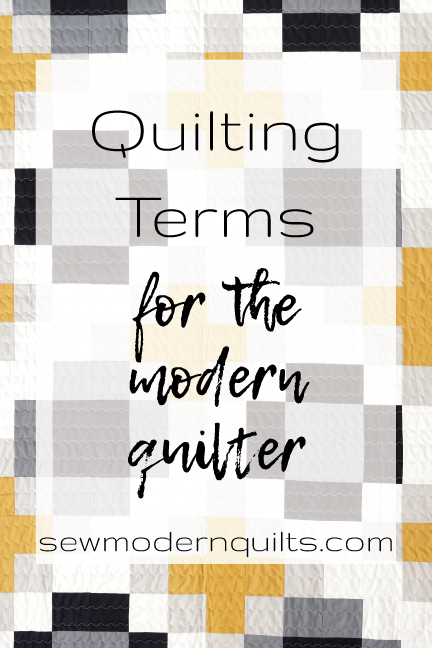Like many areas of our lives, quilting has it’s own jargon and specific set of terms that won’t be used elsewhere. Let’s have a look at some of the most commonly used terms in quilting.

Parts of a Quilt
Quilt Block is a pieced square or rectangle to be sewn into a quilt top.
Quilt top is the pieced quilt. Also known as a flimsy.
Borders surround the pieced quilt top and can vary in width. Some quilts may have more than one border too.
Batting is the middle layer of the quilted quilt. 80% Cotton/20% Polyester is most common, also look for wool, silk and bamboo battings.
Quilt Back/Backing is the third layer of a quilt. The back can be pieced or one large piece. Generally needs to be a bit larger than the front for the quilting process.
Binding is the thin strip of fabric that goes around the outside edge to finish the quilt.
Deciphering a Pattern
Width of Fabric (WOF) typically quilting cottons are 40″-45″ wide, this is the selvedge to selvedge measurement. 60″ -wide, and 108″ -wide are also common widths in fabric.
Length of Fabric (LOF) is measured in yards. Occasionally you will be asked to cut a boarder, or large strip from the length before cutting across the width.
Strips cut across the width of fabric can vary in size. Typically cut with a rotary cutter and ruler, on a cutting mat.
Crosscut/Subcut refers to the square or rectangle to be cut from the WOF strips.
Half-Square Triangles (HST) refers to two triangles making up one square in a quilt block or unit. There are many ways to make these triangles, every quilter seems to have a preference with time.
Strip piecing refers to sewing strips of fabric together, to then cut segments for your pieced pattern. Usually this is prescribed in a pattern, with segment widths to be cut.
Chain piecing is the act of piecing a number of units without cutting the thread in between each unit. This saves thread, and time as you piece.
Segments are cut from strips pieced together first. This is a fun quilting shortcut.
Stitch n’ Flip is a quick way to add an angle to a square or rectangle of fabric. Often you are instructed to mark a diagonal, and sew on the line, then trim away the excess fabric.
Flying Geese are a triangular block unit in a rectangle that is twice as wide as it is tall.
1/4″ seam allowance is the standard quilt seam allowance. Using more fabric in the seam allowance like when sewing garments would make for a very heavy quilt.
Scant 1/4″ seam allowance occasionally a slightly smaller seam allowance is needed for the correct outcome.
Fabric Specifics
Quilters Cotton is typically 100% cotton, printed with designs to appeal to quilters. The weight can vary by manufacturer. Usually 45″ wide.
Batik is also 100% cotton, but hand dyed with various wax relief designs.
Fat Quarter is a standard cut of fabric in quilt shops measuring 18″ x 22″. This piece is a fun way to collect a wider variety of fabric.
Fat Eighth is another cut of fabric growing in popularity, measures 9″ x 22″.
Jelly Roll™ is a Moda Fabrics specific cut that includes 42 – 2 1/2″ WOF strips, all coordinating and ready to sew. Available with other names by other manufacturers as well.
Layer Cake™ is a Moda Fabrics specific cut that includes 42 – 10″ squares, all coordinating and ready to sew. Available with other names by other manufacturers as well.
Charm Pack is a group of 5″ squares. These charms have been a historic way of trading fabric scraps. Currently you can purchase sets of charms that are coordinating and ready to sew from many of the fabric manufacturers.
Solid Fabric is available without printing in a wide variety of colors. These fabrics are dyed not printed and a great addition to your modern quilt.
Modern Specific
Improv Piecing a manner of piecing without a specific pattern, or rulers. This free-form method of piecing offers spontaneity in quilt tops.
Negative Space in a quilt is the open area around a focal point.
Off-set grid is a non-traditional grid of blocks or negative space within a quilt top.
Modern Traditionalism is when a quilter uses a traditional block for inspiration or in a new way.
Group or Bee Quilt occurs when a group of quilters each make a block within set parameters for one of the group members. That member will piece all the blocks together and finish with quilting.
Tools
Rotary Cutter is a revolutionary tool for quilters! With the rotary cutter we are able to cut shapes en masse – but take care! The blade can seriously injure fingers.
Cutting Mat is used with the rotary cutter, to protect your surface and the longevity of the blade. Many cutting mats are printed with measurements to assist in cutting accurately.
Acrylic Rulers are also used with the rotary cutter, and are available in a wide variety of widths and lengths. I suggest a new quilter invest in a 6″ x 24″ and 6″ square ruler to begin.
Seam Ripper is a handy though not often liked tool for removing seams in the case of a mistake. It allows you to remove the thread without damaging the fabric.
Hopefully that clears up some of the quilting terms confusion for you! There’s always more to learn. I look forward to inspiring you!
Amy

Pingback:Quilting 101 – Amanda Farmer